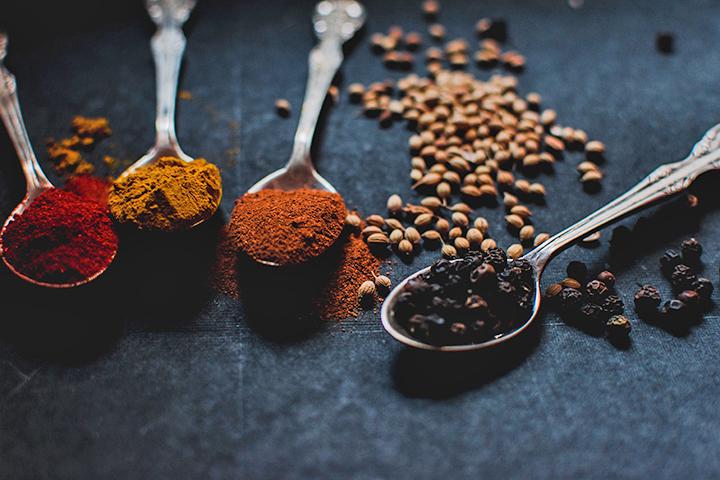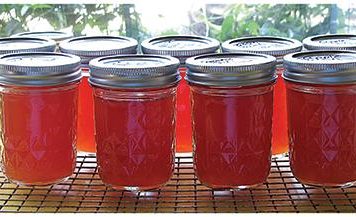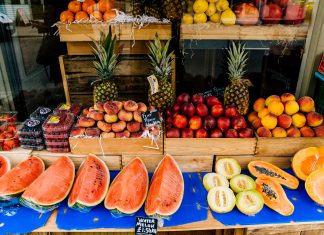| Issue #122 • March/April, 2010 |
In a perfect world, we would get all the nutrients and medication we needed from the food we ate. However, our diets and the foods available to us have changed in the past century, so that eating healthily can be a challenge. Most of us have a spice rack filled with seasonings we grab in a hurry, but what do we know about these ancient herbs and their medicinal powers?
Understanding the importance of adding oregano or basil to your spaghetti sauce, not as flavor but as a digestive aid is just one of the keys to turning your kitchen into the pharmacy it was meant to be.
Kelly M. Shattuck, a Certified Herbalist based in North Carolina, says before health food stores made specific herbs such as valerian root readily available for medicinal healing, individuals relied on their culinary herbs to play a very important pharmaceutical role.
“The great thing about culinary herbs,” said Shattuck, “is that a lot people already have them in their kitchen for seasoning, which makes the whole process less intimidating.” She also says using kitchen herbs is typically less expensive, and doesn’t require a lot of herbal knowledge or monetary investment. “Anyone can successfully use herbs as they were meant to be used, to heal and regenerate the body,” said Shattuck. “It’s just a matter of reading material, taking what you already have on your spice rack, and putting what you read into practice.”
Before you begin to take stock of your spice rack, let’s look at preparation methods.
Brewing herbal teas
Use one teaspoon of dried herb or two tablespoons of fresh herb for each cup of water.
The most common method for making a brewed tea is called an infusion.

“Infusions are used for preparing more fragile parts of the herbs like flowers, seeds, leaves, fruits, and a few roots that are high in volatile oils, for example: valerian root and golden seal root,” said Shattuck. “Place the herbs in a pan of cold water, place a tight fitting lid on the pan, and slowly over low heat bring the water to boiling point. Take the brew off the heat right before it boils and let it sit 10 to 20 minutes.”
A decoction is used to break down more tenacious herb materials such as roots, bark, and nuts. “Bring water to a boil, add the herbs, bring heat down to a gentle simmer and let brew for 15 to 20 minutes before turning off heat,” said Shattuck who also recommends soaking tenacious herb materials overnight to soften material before simmering.
Shattuck doesn’t use a tea ball when infusing teas, she says it’s best to put the loose herbs into the water so that the herb material is able to completely release its properties. Be sure to strain before drinking.
Your medicine cabinet
Basil (Ocimum basilicum)Most commonly found in Italian dishes, basil is best added at the last moment, as cooking quickly destroys the flavor. Basil makes an excellent flavoring for sauces, pesto, dressings, infused oils, and vinegars. You’ll find it complements chicken, fish, and pasta dishesnot to mention tomatoes and mozzarella during the summer.
As a medicinal herb, basil is commonly used to treat stress-induced insomnia, tension, nervous indigestion, and has been recommended as a tonic for melancholy spirits. As part of the mint family, basil can be very cooling to the body. Shattuck recommends infusing minced basil leaves and making a tea before nighttime to help you relax and settle down for the evening. As a natural mood enhancer, adding basil to your culinary dishes just provides the additional benefit of mental well being.
Bay leaves (Laurus nobilis)Used as a dry leaf since the flavor intensifies after drying, bay leaves are most often added to stock, stews, braises, and grain dishes. The fragrance of the bay leaf is slightly floral, herbal, and similar in scent to oregano and thyme.
Bay leaves have an especially beneficial effect on the stomach and intestinal tract, and contain a property that makes them useful as an alkalizing aid for an overly acidic system. A simple remedy would be to add extra bay leaves to your soups, stews, and stocks. You can also infuse a tea with a handful of leaves, and drink that after your meal to calm the intestinal tract.
Black pepper (Piper nigrum)Dried pepper, derived from the peppercorn, is one of the most commonly used spices in European cuisineit’s always seen paired with its mate, salt. Typically, pepper is used as a basic spice for almost any savory dish.
Considered one of the great tonics in Chinese medicine, black pepper has warming, energizing, and stimulating properties. Often used as an addition to other infusions, black pepper is valued for its ability to stimulate the senses and warm the body. Shattuck recommends using black peppercorns in a decoction for poor circulation, for colds, or for low energy levels.
Black pepper is also a cook’s best friend. In the event you cut yourself while working in the kitchen, pepper applied directly to the cut will stem bleeding.
Cayenne (Capsicum annuum)Cayenne is the most potent, essential, and safest stimulant in your spice rack. In the event you are out camping or hunting, be sure to pack a little cayenne. As a hemostatic and astringent, cayenne powder applied topically to wounds will arrest bleeding, working rapidly to form a clot and seal off the wound. It can also be taken for internal bleeding as well. Cayenne is a wonderful heart tonic, and has an amazing effect upon circulation and stimulation of the cardiovascular system. For those who feel weak and often chilled, cayenne taken internally increases circulation in the extremities. Cayenne is also helpful for a sluggish digestive system, and can be sprinkled over any kind of food to aid the body’s immune system in the event of colds and flus. When you need extra heat use cayennein both culinary dishes and physical wellness. Powdered cayenne has been favored by many as a winter remedy to prevent cold feet and frostbitesprinkle it in your socks to aid warmth in frigid temperatures.
Cinnamon (Cinnamomum verum)Cinnamon has long been valued as a spice of precious value, and was one of the earliest spices imported from Sri Lanka. Cinnamon can be often found in cookies, cakes, and cereals in the United States, but in the Middle East it is highly valued in savory dishes and curries. Cinnamon’s antioxidant properties make it a spice you might want to start using more frequently. Cinnamon aids the digestive system, increases poor circulation, and is being tested in the treatment of type II diabetes, as it is believed to aid in blood sugar control. Shattuck says it is often used by herbalists to make other herbs palatable. “If you had a cold, you could make a warming tea with ginger, and add cinnamon to make that tea taste better and add another element of medicinal value.” The smell of cinnamon is also thought to boost brain activity.
Cloves (Syzygium aromaticum)Cloves were one of the most highly prized spices of the middle-age spice trade. Cloves are almost always used as a spice in Indian cuisine. Cloves combined with cumin and cinnamon are found in Mexican aromatic dishes such as rice and chicken. Medicinally, the essential oils of cloves are a must in the case of a dental emergency. Applied topically to a tooth, the oil of clove is an analgesic and powerful germicidal that kills bacteria. Cloves can also reduce fever: make a decoction if you have clove buds, or an infusion if you have powdered clove to reduce a fever. Mull the cloves with cinnamon and apple peel to make a tastier tea for those suffering from acute nausea. Cloves are also believed to have antibiotic properties, and the oil can be applied topically to burns, skin rashes, or irritations like acne.
Fennel (Foeniculum vulgare)The fennel root bulb and its seed are found in Italian and Middle-Eastern cooking where the aromatic flavor is used to enhance the taste of fish, eggs, breads, and sauces. Fennel is the primary ingredient in absinthe. Medicinally, Fennel is an amazing herb to employ in your cabinet. Fennel has carminative properties (reduces gas and flatulence) and is often used when purgatives are needed to ease the side effects of purging. A wonderful digestive aid, fennel seeds can be used to make an infusion you can drink after a meal to help digest a food that might cause gassiness or bloating. You can also sprinkle a spoonful of fennel seeds on your food if you have a cold to clear congestion as fennel helps remove mucous from the body. Fennel is also used to enrich the quality and quantity of a nursing mother’s milkfennel capsules are best if a mother is trying to increase milk supply, so that she is getting a more concentrated amount of fennel than with tea. Fennel also is used to make “Gripe Water” for infantswhich is a mixture of sodium bicarbonate, syrup, and either fennel, anise, or dill water. In Indian medicine, fennel seeds are believed to improve one’s eyesight. In the event of eye inflammation or soreness, room temperature fennel tea can be applied topically with an eyedropper.
Sage (Salvia officinalis)Sage is found in many traditional European dishes. Its slightly peppery flavor and savory leanings make it best when added to meats and cheeses. And no stuffing would be complete without a good pinch of sage. Sage also enhances pork flavors and makes an excellent sausage spice.
Sage is believed to have medicinal properties for almost any ailment. You can make an infusion and use it as an astringent. Sage has antibiotic properties and is effective in improving a weak digestive system and cutting excess mucous. Sage tea is an excellent remedy for a chronic winter cough. A cleansing herb, sage can also be used as a tonic for low energy. For lactating mothers, sage is also effective in assisting slowing down the milk supply when weaning a baby from mother’s milk. Sage has a place historically as an herb that is used to cleanse and purify a space, increase fertility when burned, ward off evil, and heal snake-bites.
Garlic (Allium sativum)Garlic is used all over the world as a culinary herb for its pungent flavor and seasoning versatility. You can add fresh or powdered garlic to soups, stews, stocks, meat dishes, and risottos to name a few. Garlic is the herb of choice for colds, flus, and sore throats. Garlic is a very powerful anti-fungal and has antibiotic properties. In the event of a cold or flu, add powdered garlic to your mealsprinkle on your salad for added flavor and herbal healing. Shattuck recommends making the following cold-fighting concoction using whole cloves during the winter. “Peel about eight or nine garlic cloves and put in a glass jar with equal parts honey and tamari or soy sauce that completely covers the top of the cloves,” she said, allow the mixture to marinate for several weeks and then eat one or two cloves per day if you feel a cold coming on. Garlic is an immune booster and is believed to lower cholesterol levels. Garlic is also used in humans and animals for expelling parasites and ridding the body of intestinal worms. Garlic can be used as an infection fighter and anti-fungal compound. Crushed garlic is useful in healing thrush and strep throat. At the first signs of a scratchy throat, begin self dosing with garlic cloves or powder. You can alleviate “garlic breath” by chewing fresh parsley.
Ginger (Zingiber officinale)Ginger is an ancient Asian spice that can be found in many desserts, curries, candies, seafood dishes, and vegetarian stir-fries. Recently, candied ginger has become readily available and has shown up in coffee drinks and on the top of cream cheese frosted cupcakes.
Ginger is an excellent remedy for morning sickness and motion sickness. Shattuck recommends taking candied ginger on any “seafaring” trip in the event of nausea. Ginger is not only an excellent warming herb but acts as a decongestantin the event of a fever, draw a hot bath and sprinkle a handful of powdered ginger in your water. The bath will induce your body to sweat out impurities, provide warming in the event of chills, and help your congestion break-up. Towel off, put on some warm flannels, and go to bed. You can brew an infusion of fresh ginger to help a sore throat.
Ginger can also stop diarrhea and provide relief from arthritic inflammation.
Nutmeg (Myristica fragrans)Nutmeg has a slightly sweet spicy flavor that is often used in cheese sauces to add a delicate taste, or in brewed drinks like eggnog, mulled wine, and mulled cider.
Nutmeg is very useful as a remedy for nausea, vomiting, and indigestion, and also helpful for diarrhea related to food poisoning. Shattuck says in the event of food poisoning, nutmeg can settle the stomach. She advises sprinkling powder or grating whole nutmeg over plain brown rice to reintroduce solids, and to make a tea for those who are still unable to keep anything down. If used improperly, large doses of nutmeg could be toxic.
Oregano (Origanum vulgare)Oregano (and basil) give Italian cuisine its distinctive flavor, and is more flavorful in its dried state than as a fresh herb. Found in Greek cuisine, oregano is a wonderful addition to salads, aromatic oils, and meat dishes. In the United States, oregano is a staple on pizza. Oregano can help strengthen the immune system, heal digestive eruptions, and is proven to have antioxidant properties, Hippocrates, the father of medicine, advised using oregano as an antiseptic and for respiratory ailments. Oregano can aid in restful sleep, and an infused tea before bed is advised for nervous temperaments. Oregano is helpful in fighting skin infections. Shattuck says you can add oregano to your bath if you have a skin condition or persistent rash. “Take a handful of Oregano, tie it in a handkerchief, and toss it in your bath water.”
Peppermint (Mentha × piperita)Peppermint is an easy herb to cultivate and keep in one’s spice rack. Believed to be the world’s oldest medicine, it is often found in teas, candies, chewing gum, and toothpaste. It is a soothing herb that provides a nice pick-me-up for fatigue. It is highly calming to the digestive system and especially good for ulcerative colitis and Crohn’s disease because of its natural calming properties. Shattuck recommends those with intestinal issues invest in peppermint oil capsules that will get into the intestines in a concentrated form. Peppermint is one of the tastier herbs, and makes a perfect infusion with a little raw honey. In studies conducted in Italy in 2007, peppermint oil was also found to relieve symptoms of Irritable Bowel Syndrome.
Rosemary (Rosmarinus officinalis)Rosemary has a woodsy evergreen smell that complements many Mediterranean dishes. Rosemary makes an excellent addition to meat gravies, risotto dishes, and stocks. Rosemary is high in iron, calcium, and Vitamin B6. It has long been believed to help the mind in retaining information, and Shakespeare called it the herb of “remembrance.” Rosemary can provide relief for headaches through aromatherapy and ingestion. Rosemary is often used to combat depression and is an excellent all around herb for the mind.
Thyme (Thymus vulgaris)Thyme is a natural source of iron and is found widely in culinary dishes all over the world. It was used by ancient Egyptians in the embalming process, and has long been believed to purify the body and environment.
Another herb most flavorful in its dried state, thyme is found in many lamb, tomato, and egg dishes. Its natural expectorant properties make it excellent for throat or bronchial problems. Thyme is a natural antiseptic, and you can make a thyme infusion and gargle with it to coat a sore throat up to three times daily to reduce inflammation. Its antibiotic properties makes thyme a well favored herb in a first-aid kitancient doctors used thyme to coat bandages, and it is believed to have anti-fungal properties that assist in healing an infected or fungal toenail. In the event of a respiratory infection, you can make an infusion and then let the affected individual bend over the steaming thyme infusion and inhale. Traditional use of thyme included giving it to children at bedtime to help control bed wetting and nightmares. Tea is the easiest way to administer to children; if they are worried about the taste you can mix it with apple juice (half-and-half).
Culinary herbs enhance our daily cuisine, but they also have medicinal properties that have been all but forgotten. Focus on the herbs you are using when seasoning your next meal; it’s amazing what a little knowledge can do for boosting one’s confidence in natural herbal healing.














